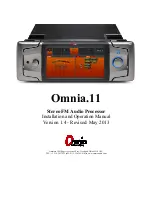
19
20
This enables information to be sent over a T1 connection
without any constraints on the data’s pulse density. This is the
most acceptable way to accomplish 64 kb/s on each DS0
channel.
B7ZS:
This stands for Bipolar Seven Zero Substitution. Instead of
introducing bipolar violations, this method substitutes a one
for a zero in bit 7 (out of 8) of a DS0 channel when the data in
that channel are all zeros. This is a special form of AMI and is
compatible only with special equipment. For most applica-
tions, AMI or B8ZS will suffice.
DS0 Line Rate
: 64kbps
(default)
Options:
64kbps, 56kbps
64kbps:
Also known as Clear Channel, this takes full advantage
of the available bandwidth in a DS0 channel. Implementing it
usually requires B8ZS line coding. In certain cases, special
equipment may implement Clear Channel using AMI or B7ZS.
Consult the equipment manual for compatibility. Your carrier
will advise you on whether to use 64 or 56 kb/s. Campus
applications may not have such restrictions, enabling you to
use 64kbps. In Unframed format, the 24 DS0s and the fram-
ing bits are combined to provide 1.544Mb/s for your use.
56kbps:
This uses only the first seven bits of the DS0, limiting the
data rate per DS0 channel to 56 kb/s. Your carrier will advise
you on whether to use 64 or 56 kb/s. This is not available
when using the Unframed format.
ESF Data Link:
ANSI T1.403
(default)
Options:
ANSI T1.403, AT&T TR54016
ANSI T1.403:
This ANSI developed standard (see ANSI T1.403-
1995: Network-to-Customer Installation—DS1 Metallic
Interface) uses the FDL to send and receive one second
Performance Report Messages (PRMs). The messages con-
tain the NI performance over the last four seconds. Thus, up
to three consecutive messages may be lost without loss of
information. It is available only with ESF. When ANSI T1.403
is selected, requests to send AT&T performance reports (ref.
AT&T TR 54016) are ignored.
AT&T TR54016:
Developed by AT&T, this FDL method differs
principally from the ANSI method in two ways: First, the ANSI
method transmits messages continuously, whereas the AT&T
method transmits a performance report only upon a request
from the remote end for a report. Second, the AT&T method
provides a historical summary, up to the last 24 hours, of NI
performance. Only the service provider or special test equip-
ment can send these requests. When AT&T TR54016 is
selected, ANSI PRMs are still transmitted by the unit, but only
PRMs sent by the carrier will be recognized. To receive PRMs
from another customer unit (i.e., in a campus application),
select ANSI T1.403. When the frame is not ESF, the FDL is
disabled.
ESF Carrier Loops
: Enabled
(default)
Options:
Enabled, Disabled
The ESF format provides the CO the ability to put the customer
installation’s Model 2720 into loopback mode. The Model 2720 recog-
nizes these special messages that are sent over the FDL. When
enabled, the unit will respond to these loopback commands and go into
or out of loopback mode. When disabled, the unit will not respond,
although it still recognizes the loopback commands. When in loopback,
the unit will remain in loopback until a loopback exit command is
received or when the loopback timer times out. See
Unit Options
(
Section 3.2.4
) to make Loop Timeout choices. This feature allows the
remote user to regain control should one be locked out after a loop-
back is initiated.
Summary of Contents for 2720/I Series
Page 45: ......
Page 46: ......
Page 47: ......
Page 48: ...Copyright 2001 2007 Patton Electronics Company All Rights Reserved...
















































